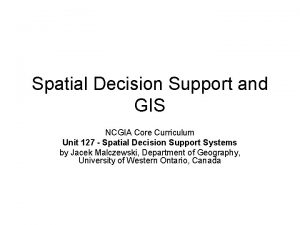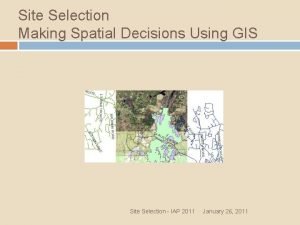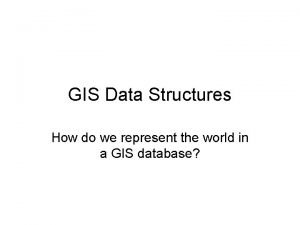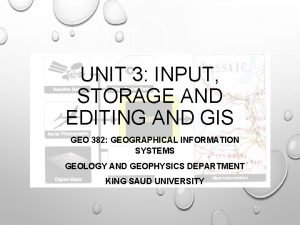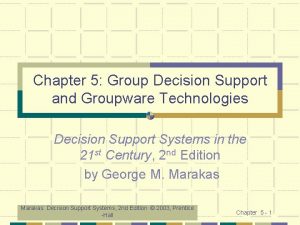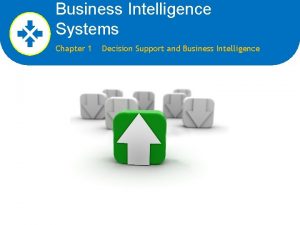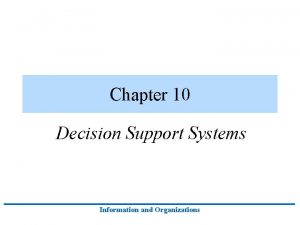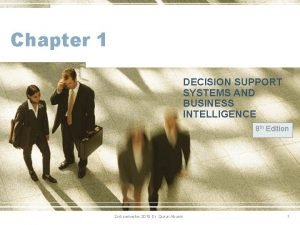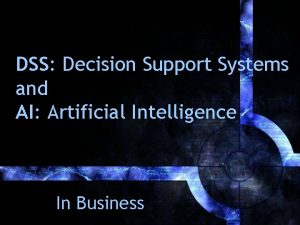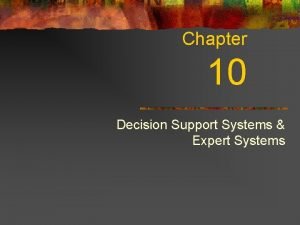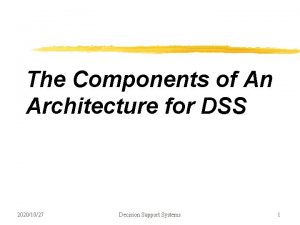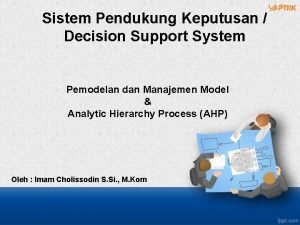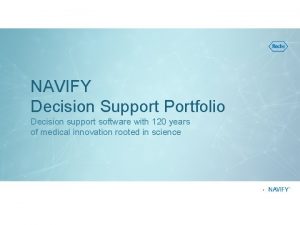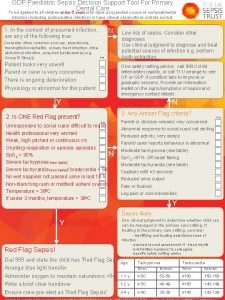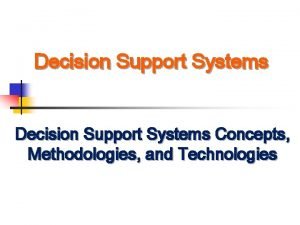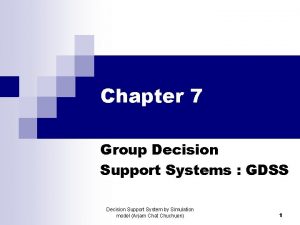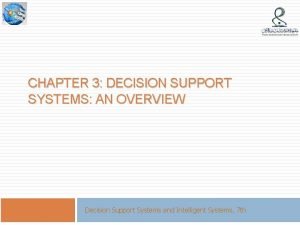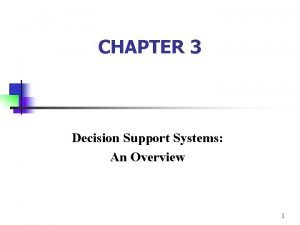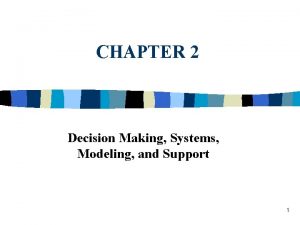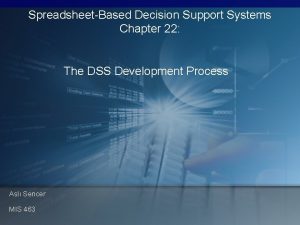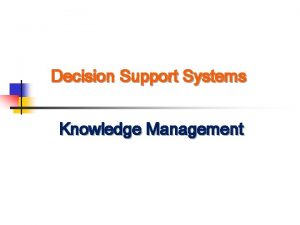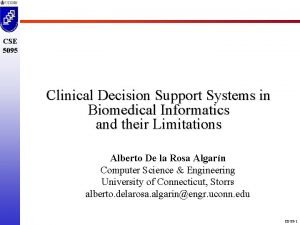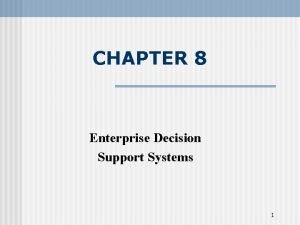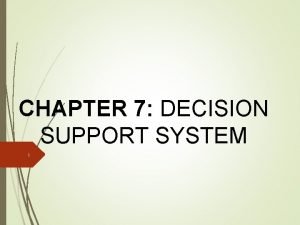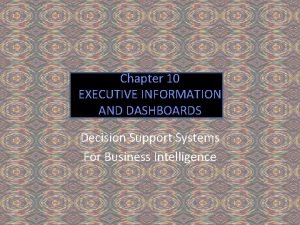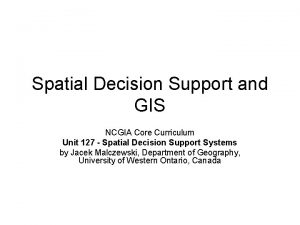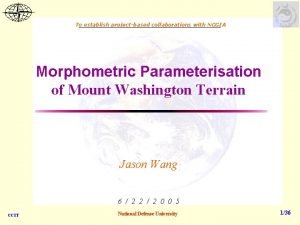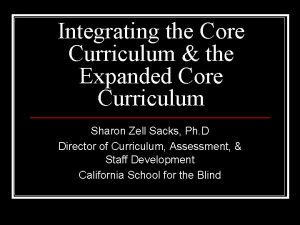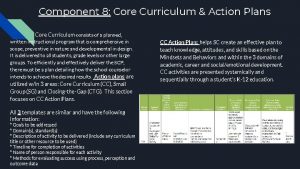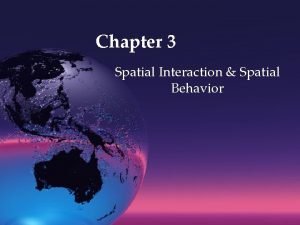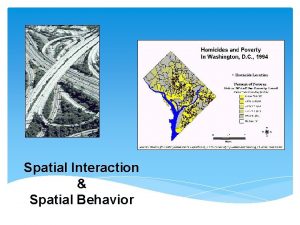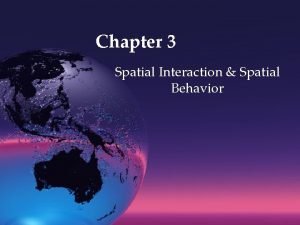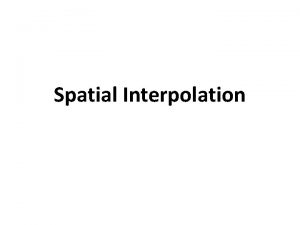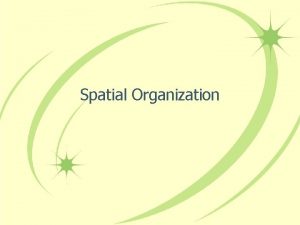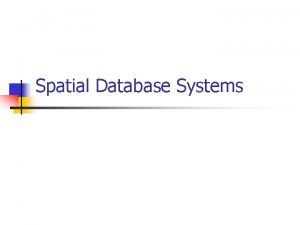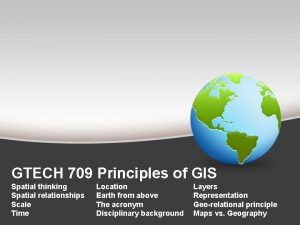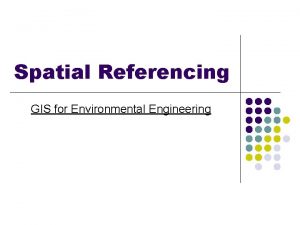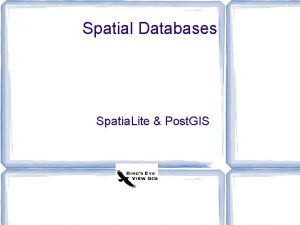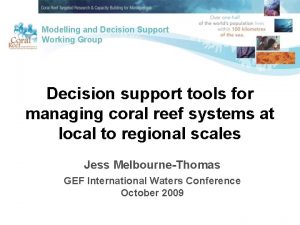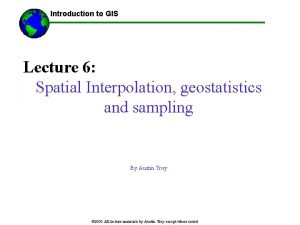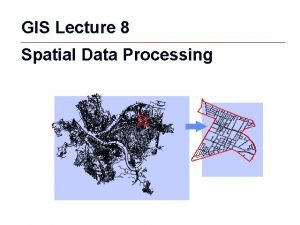Spatial Decision Support and GIS NCGIA Core Curriculum






































- Slides: 38

Spatial Decision Support and GIS NCGIA Core Curriculum Unit 127 - Spatial Decision Support Systems by Jacek Malczewski, Department of Geography, University of Western Ontario, Canada

Using GIS • GIS and computers can synthesize data and perform analysis and modeling • But PEOPLE make decisions! • How can GIS be used as part of the decision-making process? • Decisions can be top down (managers) or bottom-up (public participation)

A US ideal: Freedom of Speech

Spatial Decision Problems The main characteristics of spatial decision problems include: – – – Many alternatives, Consequences of the decision alternatives are spatially variable Each alternative is evaluated on the basis of multiple criteria, Some of the criteria are qualitative others quantitative More then one decision maker (or interest group) involved in the decision-making process – Decision makers have different preferences on evaluation criteria and decision consequences – Decisions are often surrounded by uncertainty – NIMBYism etc.

Emergency Management Decision Support GIS For the Tampa Bay Region

Emergency Management • Domestic preparedness • Vulnerability Assesments • Mitigation planning • Training • Incident management • Recovery

Storm Categories

a C 3 t H r r u e n ica Storm Categories

RVAM Extreme Risk Property Owners Notify Now Plot Storm Track Input Wind Radii Identify Parcels Notify Owners Assess Damage Assess Future Growth Scenarios

RVAM Risk Damage Assessment Assess Now Assessment Complete Parcels Affected Plot Storm Track Extreme 5299 High 5343 Identify Parcels Moderate 7167 Notify Owners Input Wind Radii Assess Damage $ Building Loss Estimate Extreme 100% Loss High 75% Loss Moderate 50% Loss 1, 964, 336, 700 1, 830, 798, 900 591, 793, 600 Future Growth Losses Save Results and Exit? Scenario 1 12, 382, 300 Yes Scenario 2 7, 564, 900 No No Assess Future Growth Scenarios

Historical Background • Decision Support System (DSS) based on work by Herbert A. Simon in 1950 s and 1960 s (Simon 1960); • DSS evolved during the 1970 s and 80 s • SDSS concept has evolved in parallel • IBM's Geodata Analysis and Display System 1970 s earliest large DSS • SDSS has been associated with the need to expand the GIS capabilities for complex, ill-defined, spatial decision problems • Major growth in research, development, and applications of SDSS in the last 10 years • Many threads with different, but related names, such as collaborative SDSS, group SDSS, environmental DSS, spatial knowledge based and expert systems, PPGIS

The Decision-making Process • Simon divides any decision-making process into the phases of decisionmaking – intelligence - is there a problem or an opportunity for change? – design - what are the decision alternatives? – choice - which alternative is best?

Simon’s Model

Planning Stages • • Problems Goals Objectives Alternatives Evaluations Choice Implementation Monitoring

Planning Methods • • • SWOT Bargaining Brainstorming DELPHI Scenario writing Consensus building Public meeting support Charrette Consultants Stakeholder involvement Outreach

Example: Community. Viz

GIS and Decision Support • GISystems have limited capabilities to support the design and choice phases of the decision-making process • GIS provides a static modeling environment , reducing their scope as decision support tools • Especially so in the context of problems involving collaborative decision-making

What is SDSS? • SDSS is an interactive, computer-based system designed to support a user or group of users in achieving a higher effectiveness of decision making while solving a semi-structured spatial decision problem; • The three terms (semi-structured spatial problems, effectiveness, and decision support) capture the essence of the SDSS concept

Components of SDSS • Data Base Management System contains the functions to manage the geographic data base • Model Base Management System contains the functions to manage the model base; • Dialog Generation and Management System manages the interface between the user and the rest of the system.

DSS Tools • Procedural programming languages and code libraries (e. g. , VB, AML, Avenue, Trans. CAD - Caliper Script macro language, Map. Info - Map. Basic); • Visual progamming language (e. g. STELLA, Cantata and Khoros); • Inter-application communication software (e. g. dynamic data exchange (DDE), object linking (OLE), open database connectivity (ODBC)); • Simulation languages and software (e. g. SIMULINK, SIMULA); • Application programming interfaces (API) (e. g. the IBM's geo. Manager API, Java Advanced Imaging API, Trans. CAD's API); • Applets (e. g. GISApplet, Microsoft Visual J++), • Visual interfaces, graphics and color subroutines (e. g. graphical user interfaces – GUI, Open. GL, SVG, etc. )

DSS Generator • Package of related hardware and software which provides a set of capabilities to quickly and easily build a specific SDSS • GISystems (e. g. ARC/INFO, Arc. View, ARCNetwork, Spatial Analyst, Map. Objects LT, GRASS, IDRISI, Map. Info, Trans. CAD) • Database packages (e. g. d. Base, Access, Paradox); • Decision analysis and optimization software (e. g. LINDO, EXPERT CHOICE, LOGICAL DECISION); • Statistical and geostatistical software (e. g. S-PLUS, SPSS, SAS); • Simulation (e. g. Spatial Modeling Environment)

Specific DSS • Systems devoted to the analysis of a particular set of decision problems • Support decision makers in tackling semistructured problems • Active Response Geographic Information System • IDRISI Decision Support • Geo. Med • Spatial Group Choice • win. R+GIS Spatial Decision Support • Community. Vis

Example: Nuclear power

Since December, 1942: 130 sites Source: www. prop 1. org/ 2000/noflymap. htm

77, 000 tons of highly toxic waste that will be radioactive for hundreds of thousands of years

Where is it now? Wet and dry Source: www. aecl. ca

50 years of decision-making • 1957 NRC report recommended burying the waste in a permanent repository • Need a “safe” site for 77, 000 tons of highly radioactive waste • Safe means stable for at least 10, 000 years as measured by radionuclides in surface and ground water downstream • Need a stable place, free from hazards • Storage-movement-disposal issues • No solution in spite of 1982 act (DOE by 1998). • Single site eventually chosen

Yucca Mountain, NV

Problem 1: The journey to Yucca Mt.

Problem 2: Burial

Yucca Mountain Waste Repository What is the radionuclide travel time from the repository to the water table? Question addressed through modeling • Conceptual model selection • Calibration • Predictions

UZ Travel Time Predictions: 1995 -2003 Early models Data collection, revised conceptual model, computational model advances Current models Effective Continuum Dual Permeability • Fractures and matrix assumed to be in pressure equilibrium • Calibration yielded water perc. rates of 0. 01 to 0. 1 mm/y, dry fractures • Travel times to water table of about 350, 000 years • Fractures can flow even when matrix is unsaturated • Calibration could be attained with more reasonable perc. rates of 5 mm/y • Travel times to water table of 10’s to 100’s of years possible! Conceptual model uncertainty is critical to assessment of overall system uncertainty

Cl-36 Observations Confirm Rapid Transport Pathways Atmospheric fallout from nuclear weapons testing (1950’s and 1960’s) is present in fluid 200 -300 m below ground surface. Fault zones appear to be the pathway. Source: Fabryka-Martin et al. , 1997, YMP Milestone SP 2224 M 3

The Yucca Mountain Decision Model Framework 1 Climate Precipitation 4 2 Infiltration Waste Form Degradation Drift Cross Section Zone Flow Near-Field Geochemical Environment Unsaturated 7 Zone Flow and Transport Saturated Zone Flow and Transport Waste Package Degradation Seepage From Mountain Crest to Repository ~ 1, 000 feet 3 Unsaturated 8 5 Unsaturated Zone Flow Thermal Hydrology Drift Scale Tpt From Repository to Water Table ~ 1, 000 feet 6 Radionuclide Mobilization Through Engineered Barrier System Transport GDF Tcp Tcp Biosphere Water Key Attributes of Repository Safety Strategy Limited Water Contacting Waste Package Slow Release From Waste Package Long Waste Package Lifetime Low Concentration of Radionuclides in Groundwater 9 Tcp Water Well Pathway Plants ~ 20 km Amargosa Valley WATER TABLE Animals Saturated Zone People

Many unknowns • Will there be new faults and fractures in the next 100, 000 years? • Will the local tectonics remain inactive? • Who will be there to notice in 12, 005 AD? • What language do you write the warning notice in? • [etc]

Current YMP Total System Model “Overview” Can such a model be “understood” by anyone besides the developer?

Problem N: Controversy DOE Admits Yucca Mt. Safety Information May Have Been Lied About March 17, 2005, 04: 25 PM It's being called a devastating blow to the Yucca Mountain Project -- some of the government's scientific data may have been faked. Workers on the proposed nuclear waste dump are under investigation for lying about their research -- meaning the "sound science" President Bush said he was following might be wrong

Summary • SDSS has been defined as an interactive, computerbased system designed to support a user or group of users in achieving a higher effectiveness of decision making while solving a semi-structured spatial decision problem • The SDSS concept is based on the DDM (dialog, data, model) paradigm; a well-design SDSS should have balance among the three capabilities. • There are three sets of technologies for building an SDSS: the DSS development tools, the DSS generators, and specific SDSS • The DSS tools facilite the development of specific SDSS or they can be configured into a DSS generator which in turn can be used to build a variety of specific SDSS.
 Ncgia core curriculum
Ncgia core curriculum No decision snap decision responsible decision
No decision snap decision responsible decision Financial management process
Financial management process Spatial data vs non spatial data
Spatial data vs non spatial data Making spatial decisions using gis
Making spatial decisions using gis Spatial data structures in gis
Spatial data structures in gis Gis data input
Gis data input Decision table and decision tree examples
Decision table and decision tree examples Inner core and outer core
Inner core and outer core Earth mantle definition
Earth mantle definition Core rigidity
Core rigidity Decision support systems and intelligent systems
Decision support systems and intelligent systems Mdm support technologies in dss
Mdm support technologies in dss Decision support and business intelligence systems
Decision support and business intelligence systems Decision support system advantages and disadvantages
Decision support system advantages and disadvantages Decision support and business intelligence systems
Decision support and business intelligence systems Expert system and decision support system
Expert system and decision support system Expert system and decision support system
Expert system and decision support system Decision support and expert systems
Decision support and expert systems Supporting details major and minor
Supporting details major and minor Basic layers of the earth
Basic layers of the earth Curriculum development models
Curriculum development models Transaction processing system examples
Transaction processing system examples Architecture of dss
Architecture of dss Contoh decision support system
Contoh decision support system Navify decision support
Navify decision support Gdp sepsis decision support tool
Gdp sepsis decision support tool Components of decision support system
Components of decision support system Components of group decision support system
Components of group decision support system Characteristics of a decision support system
Characteristics of a decision support system Components of decision support system
Components of decision support system Systematic decision making process
Systematic decision making process Developing spreadsheet-based decision support systems
Developing spreadsheet-based decision support systems Model driven decision support system
Model driven decision support system Knowledge management decision support
Knowledge management decision support Iliad clinical decision support system
Iliad clinical decision support system Executive support system
Executive support system Objectives of decision support system
Objectives of decision support system Chapter 10
Chapter 10
